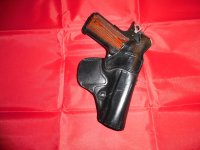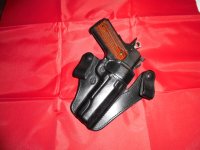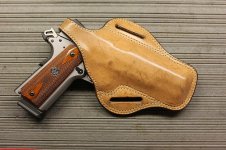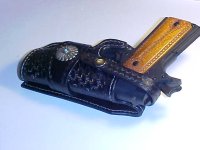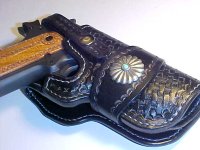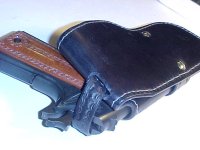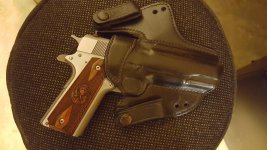I have seen some holsters with what looks like a thumb break or something to protect the exposed cocked hammer. Others don't have anything to protect the hammer.
That strap actually exists to do two things: hold the gun in the holster, and prevent a discharge. The former is obvious, the latter will become so.
The 1911-pattern pistol features a grip safety, and a manual thumb-activated safety. It's also got a short, relatively light single-action trigger pull (even a conservative carry gun might have a trigger as light as 5#, and some match pistols go to 2# or less!).
In carry, the grip safety is easily deactivated unintentionally. It's powered by a relatively light leaf spring, and typically deactivates when pushed in ~2/3rds of the way in most setups.
The thumb safety, if you note, is not only located on the body side, it's also a fairly large paddle. This means it's very easy to deactivate it unintentionally, just moving around. That's why you frequently see standard or even under-sized thumb safeties on defensive pistols. The standard-sized thumb safety is quite easy to operate for most hands, and some even use it as a thumb-rest.
Most 1911 pistols sold today are what's called "Series 70". This means that they have no firing pin block. A Series 80 pistol does have a firing pin block, but they're almost universally maligned.
Now, it's quite easy, as well, to booger up a 1911 trigger. If you damage the sear/hammer engagement surfaces, or bend your sear spring the wrong way when adjusting it, or even during assembly, you can have a situation where the hammer can fall right off the sear.
The half-cock notch is actually designed to "catch" the hammer slightly. In other words, if the hammer falls off the full-cock notch, it catches and stops on the half-cock notch, or the half-cock notch slows the hammer down enough to prevent a discharge.
But, if you have a Series 70 pistol with no firing pin block or a disabled/malfunctioning Series 80,
and the thumb safety is disengaged,
and the hammer is jarred off the sear,
and the half-cock notch fails to do its job, you can have a completely unintended, mechanically-induced discharge. Since so many people monkey around with their 1911s (Lord knows I tinker with mine), or build their own (working on it), these aren't exactly completely unknown events.
Alternatively, if your trigger is light, your holster is way too soft, or your trigger shoe is way too wide for carry, you can simply accidentally pull the trigger with the gun holstered. Remember, most 1911s have a clean-break trigger--minimal take-up, and no movement during the pull itself. For that to happen, all you'd need is to have the thumb and grip safeties deactivated, which is easy to do.
Bad news if the gun happens to be holstered when you do this!
Hence, the thumb strap. It physically sits in between the hammer and the firing pin, putting an end to all that badness while securely holding the gun in the holster.
Now, in a normally-functioning gun that's suitable for carry (i.e.--not the SA Range Officer with the sub-2# "cheater" trigger you use in Bullseye), having such a mechanical failure is extremely unlikely. With a carry-friendly trigger pull, it's simply difficult to do mechanically. That's because the trigger pull weight is mostly dependent on the pressure that the sear spring puts on the sear and disconnector. If you've got a moderate-to-heavy trigger pull, then its more difficult to jar the hammer off a worn sear/hammer engagement surface. If it's going to slip, it's more likely to slip when you chamber a round.
And that moderate-to-heavy trigger pull means there's sufficient pressure for the half-cock notch to "catch" the hammer on the way down, and break its fall.
Welcome to 1911s.
Were I to carry my 1911, I'd frankly be fine with anything. If I could get it, the thumbstrap style is quite nice. I actually pack mine around the range with one regularly--can you imagine telling the officer, "Yes, I got robbed of all my guns and ammo, because they were all on the bench?" I like the security, and I like the hammer-blocking nature of it.
I wouldn't dismiss a Kydex, or something else that gave decent retention. But my gun is a full-size, all-steel Gov't model. It's heavy enough to bounce out if not secured.
The one caveat I would place on the thumbstrap is that it's not the best thing in the world to be shooting out of. It functions fine, but the snap button hits the gun every time you draw and holster.
You can get thumbstraps that can be buttoned around the front for shooting. Or you can get a Threepersons-style holster, which has a hammer thong--literally a thing like a leather shoelace that serves the same purpose. I would probably not carry with a Threepersons, but they were designed for that, and I have never used one, nor looked too closely at one for a 1911.


